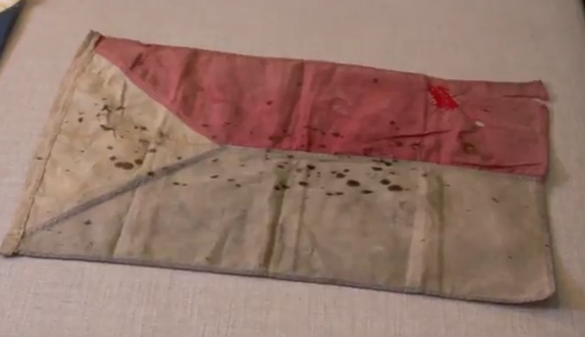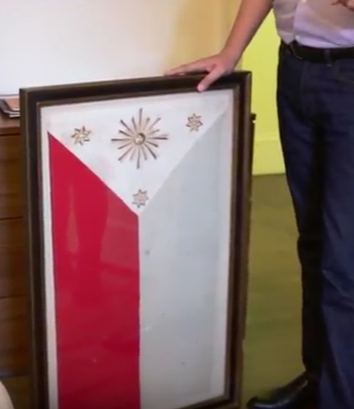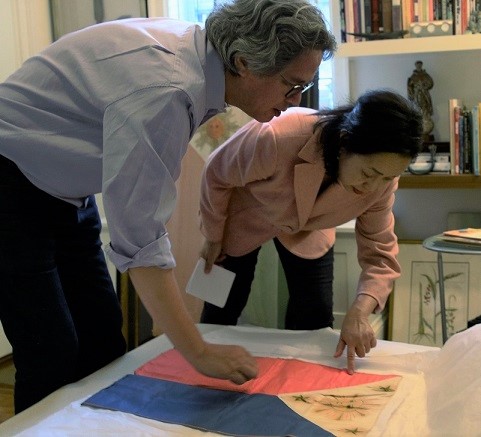LOOK: NYU dean’s collection — the flags of our forefathers

WATCH: NYU Dean for Science Michael Purugganan explains his flag collection. ANUZ THAPA
NEW YORK — It was a walk-back to the past, my visit with NYU Dean for Science Michael Purugganan one Saturday morning at his Washington Square West apartment.
Michael is an avid collector of Philippine artifacts. It is his collection of early Philippine flags, I came to see.
Through them, I learned a little bit about how Filipino soldiers and the common folks honored their flags during the tumultuous period of the Philippine revolution in 1896 and then the war against the United States from 1898 to 1902.
“This flag,” he said almost solemnly pointing to blood spots, holes and tears in the faded fabric, “someone died fighting for this flag.” He fell silent as he scanned the colors neatly laid out on a bed in his guest room, thinking of the “heroism of our soldiers.”
Michael’s collection of books, maps, wooden sculptures, flags and swords are from the revolutionary period, or the juncture before the Philippines declared independence. It is a fascinating era for him.
“It is one of the most important times in our history. I think of all the people in that era – Rizal, Bonifacio, Jacinto, Aguinaldo — some of the greatest Filipinos who ever lived, fighting for our independence,” he mused.
They were all so young
“Makes me think about the sacrifices they were going through. They were all so young and fighting for our independence.” The collection, he added, “brings me to that period.”
One day, he attended an auction where two flags from the time of Emilio Aguinaldo – president of the first republic in 1899 to 1901 — were up for bid.
“I didn’t bid on them but I got curious,” he said.
Thus began his long, exciting and somewhat expensive, journey from one auction to another, meeting with collectors and conservators around the country and learning more arcane information that never made it to Philippine history books.
The first in his collection was a red and white flag with no blue. The flag, probably from the 1890 to early 1900s, was from Northern Luzon. He acquired it from a collector.
“I don’t know why it’s white but it could be several things,” he explained. “It could be when they were making a flag they had to make a flag (no matter what), and there was no blue fabric. So, they just decided to use white.”
The earliest in his collection is a small satin flag. In lieu of the sun is a red pin cushion lookalike with golden rays and surrounded by three stars.
No flag factories
“Several things to note about the early Philippine flags,” said Michael. “There were no flag factories at that time. We were barely forming a government. The sun is a red little cushion. (At the time) they were just using whatever material they had, and making whatever they thought their flag should look like.”
This flag was acquired from the family of an American soldier who fought in the Philippines. “Soldiers would take the flag as trophies, and their families would sell them or put them up for auction,” he said.
One of the most heart-wrenching is a seriously distressed flag, torn and mended, and with holes and dried blood spots all over the fabric.
“This is called the battle flag, the flags the troops brought into battle,” he said. “Interesting flag. It’s been mended. Think of some soldier in the battlefield trying to mend a flag…to bring it to the next battle. Somebody died fighting for this flag.”
It’s an expensive collection, no doubt, one where Michael’s wife Alessandra would sometimes give him the “are you sure” look.
“As long as it is of value to Philippines culture,” she would remind him.
Cost of preserving
A flag cost anywhere from a few dollars to several thousands. Michael won one from an eBay bid. The cost of preserving, he conceded, is worth more than the cost of purchase, but it’s all worth it.
It doesn’t matter, he said, that a collection of this importance is in private hands or held in government museums, “as long as people can see the collections and study them.”
“It feels right that we, me and other Filipino collectors, are now taking back these symbols of our country,” he said. “Eventually a large part of my collection will go back to the Philippines in some form or another.”




